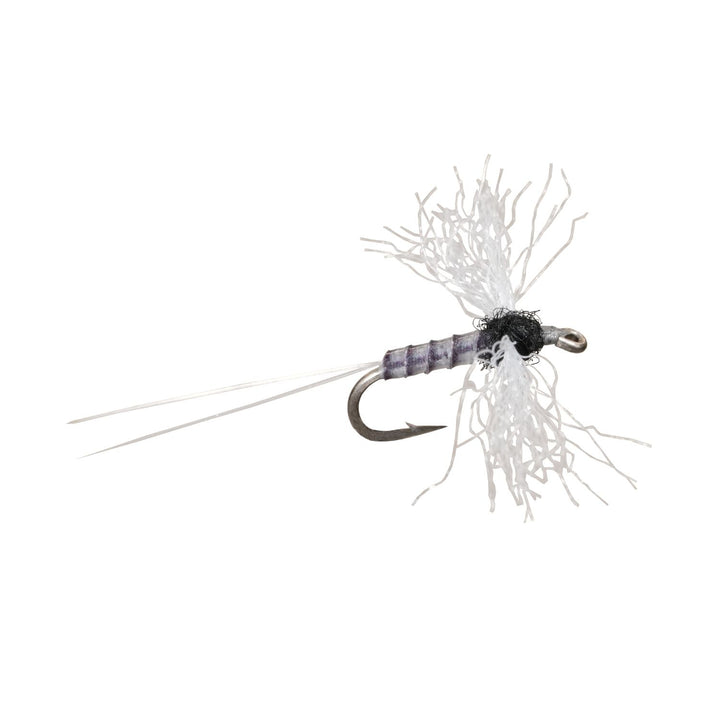13 Must-Have Summer Fly Fishing Patterns
I spend way too much time on YouTube watching fly tying and fly fishing videos. While I only subscribe to two channels, I keep a running list of others I follow — always on the lookout for fellow Utahns. It’s not always easy to tell where someone is based, but eventually, the clues add up and their location becomes clear.
Last week, I stumbled upon a video titled “Teaching Someone How to Fly Fish in One Day”. Since I’ve been trying to get my grandkids into fly fishing, I clicked right away. Then I noticed the same channel had another video titled “The Best Summer Fly Fishing Flies: 13 Must-Have Patterns | Ep. 135” Well, I’m a sucker for that kind of thing — I’m always searching for the elusive “magic fly,” so I clicked again.
That’s when I discovered that the creators behind the channel, Ventures Fly Co, are based in Lehi, Utah. Their videos are well done, informative, and their prices for flies are surprisingly reasonable.
While their list of 13 flies didn’t include all of my personal favorites, many of my go-to patterns did make the cut. So, I decided to create something for my grandkids — a write-up to help them understand what’s in their fly box and how, why, and when to use each pattern.
Here’s what I came up with. Thanks to Ventures Fly Co. for the inspiration.
1. Chubby Chernobyl (Size 10–12)

Imitates: Grasshoppers, Stonefly nymphs
Use: High-floating, excellent for dry-dropper rigs
Tying Videos: Cheech enthusiastically ties a Chubby
The Chubby Chernobyl is a foam-bodied dry fly that has become a staple in modern fly boxes, especially during summer when large terrestrials like grasshoppers and stoneflies dominate the water’s edge. With its highly buoyant foam body, flashy underwing, and robust silhouette, the Chubby floats exceptionally well—even in turbulent water—and can support a wide range of droppers, from small tungsten nymphs to even small streamers.
One of the most effective ways to fish the Chubby Chernobyl is as the top fly in a dry-dropper rig, where its buoyancy allows anglers to suspend a heavy tungsten nymph below it while still maintaining visibility and floatation. This makes it ideal for probing pocket water, seams, and riffles, where fast current would sink lesser dries. On slower water or during hatchless afternoons, the Chubby can be used alone as an attractor dry fly, drawing aggressive surface takes from opportunistic fish that mistake it for a hopper, stonefly, or even a beetle.
Cheech Pierce of Fly Fish Food is one of the fly’s most vocal proponents. In his popular tying videos, he emphasizes the Chubby’s versatility, urging tiers to “achieve happiness” by carrying it in a wide variety of sizes and colors. He particularly likes natural tones such as tan or olive paired with pearl Krystal Flash tails and white or gray wings, but he’s also quick to point out the success of brighter or more contrasting colorways for off-color water. Cheech explains that this fly is not only easy to tie but nearly impossible to sink—making it a perfect tool for summer fishing when dry-dropper or large dry techniques dominate.
To address some of the drawbacks of the standard Chubby—particularly its length and occasional bulk—Cheech developed a refined version called the Stubby Chubby. The Stubby retains all the key features of the original—foam body, synthetic wing, flashy tail—but trims down the profile to create a more compact, neater dry fly. It’s especially useful when fish are slightly more selective or when a lower-profile silhouette is needed. Cheech often fishes the Stubby Chubby on technical water or during early hopper seasons when fish are willing to look up, but not necessarily ready to commit to an oversized meal. It also pairs better with smaller nymphs in lighter rigs and is easier to cast with finesse rods or in windy conditions.
Other anglers and fly designers echo the Chubby’s effectiveness. Guides often refer to it as the “ultimate attracting floater,” capable of drawing fish from depth even when no hatch is occurring. In big western rivers like the Madison, Green, or South Fork of the Snake, it’s often used to skate across riffles, imitate fluttering stoneflies, or dead-drifted tight to the bank where hoppers fall into the current. Some even present it with a gentle twitch to give it lifelike movement when mimicking large bugs struggling on the surface.
Commercial versions such as the “Double Stack Chubby” or the “Cutter’s Chubby” offer variations in foam layers and wing structure, but the core concept remains: a highly visible, extremely buoyant dry fly that can take a beating and still ride high.
Whether it’s fished tight to grassy banks, bounced through riffles, or floated through foam lines with a nymph hanging below, the Chubby Chernobyl continues to prove itself as one of the most fun, visual, and productive dry flies of the modern era. It’s not just a summer fly—it’s a confidence pattern, a strike indicator, and an attractor all rolled into one. And for those times when subtlety matters, the Stubby Chubby offers the same reliability in a more refined silhouette—proving that when it comes to surface flies, Cheech Pierce has you covered.
2. Pat’s Rubber Legs (Size 8–10)
Imitates: Stonefly nymphs
Use: Early to late summer, dead-drifted or as part of a nymph rig
Tying Videos: Lance Egan ties Pat’s Rubber legs
Additional Tying Videos: Other Pat’s Rubber Legs Videos
Pat’s Rubber Legs is a legendary stonefly nymph pattern celebrated for its simplicity, durability, and unmatched effectiveness. Originally adapted from the classic Girdle Bug, this pattern features a chunky chenille body and wiggly rubber legs that create a lifelike, active profile. It sinks quickly and performs well long after the stonefly hatch ends. Trout continue feeding on stonefly nymphs throughout the summer, and Pat’s Rubber Legs is a staple in deep runs, pocket water, and faster riffles.
In a MidCurrent tying video, Lance Egan describes Pat’s Rubber Legs as “easy to tie and very effective.” He highlights its suitability for euro-nymphing and tight-line rigs, often tying slimmer versions with tungsten beads to improve sink rate. Lance favors the pattern not because it’s a perfect imitation, but because its size, silhouette, and motion draw consistent strikes. The rubber legs provide movement even during a dead drift, and the fly’s weight gets it down into the strike zone fast—making it ideal for technical water and fast currents.
Beyond Lance’s endorsement, the fly is trusted by guides and anglers across North America. Angler’s Covey in Colorado often recommends it for spring runoff conditions and high flows, where its bulk and movement help attract fish in murky water. They advise using it as the lead fly in a two-nymph rig, paired with a smaller mayfly or attractor pattern. In Maine, some guides have reported landing trophy brook trout on it, particularly in spring and early summer when stonefly nymphs are most active.
Presentation is key, and Pat’s Rubber Legs adapts to multiple approaches. In a traditional indicator rig, it’s fished near the bottom, where natural stonefly nymphs reside. It performs exceptionally in freestone rivers, high-gradient creeks, and deep pools. The fly’s rubber legs pulse naturally in current, but some anglers twitch the line slightly during the drift to simulate movement. In slower water, that subtle twitch can make a big difference.
For euro-nymphing, anglers tie more compact versions on jig hooks with slotted tungsten beads. These micro-jig Pat’s Rubber Legs ride hook-point up, reducing snags and allowing precise drifts through rocky slots and seams. During spring, when stoneflies migrate to the banks, fishing this pattern tight to shorelines can be especially productive. In summer, lighter color variations like golden stone or mottled brown continue to entice fish in deeper, cooler pockets.
Pat’s Rubber Legs is one of those rare flies that works across seasons, water types, and techniques. Whether fished deep on an indicator rig, high-sticked through pocket water, or tight-lined on a Euro leader, it produces consistently. Its blend of motion, weight, and silhouette makes it a confidence pattern for pros and weekend anglers alike. As Lance Egan and countless others have shown, it’s not just reliable—it’s essential.
3. Perdigon (Size 14–18)
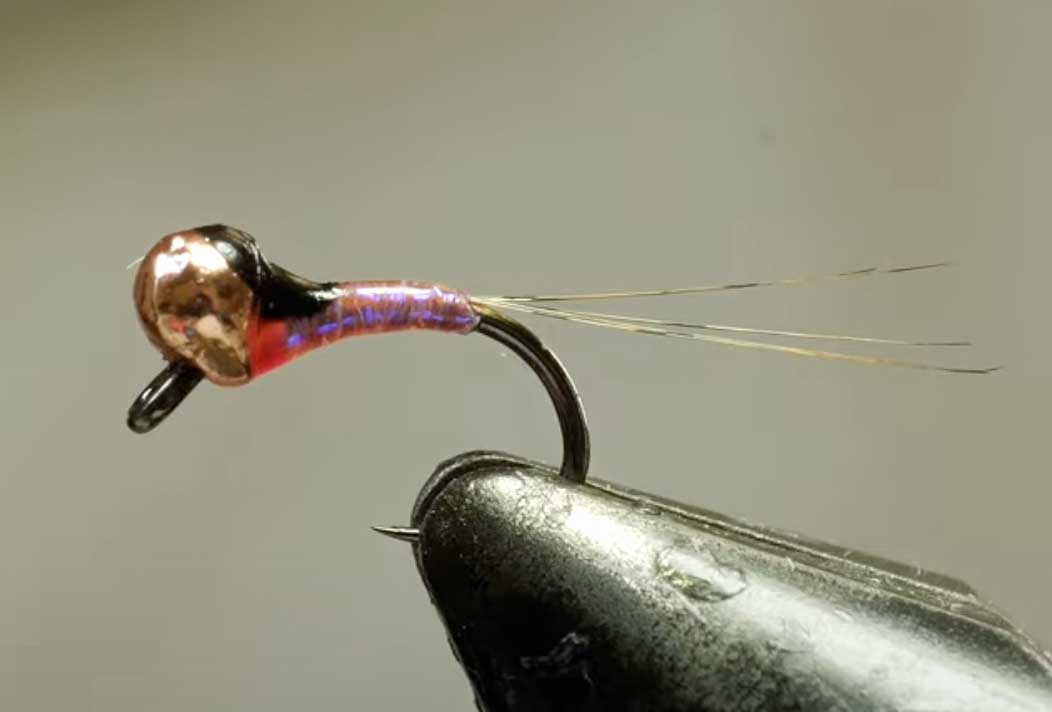
Imitates: Attractor nymph ( Mayfly/Caddis profile)
Use: Fast sinker, great for pocket water and depth control
Tying Videos: Lite Bright Perdigon
Additional Tying Videos: Additional Perdigon Videos
Devin Olsen consistently highlights the Perdigon slim-bodied, tungsten-beaded attractor nymph—as his most referenced fly in his YouTube videos. This pattern has earned a prominent place in his fly box for its unmatched versatility and performance. Designed with a minimalistic, streamlined profile and a heavy tungsten bead, the Perdigon sinks quickly, making it ideal for fast or shallow water where reaching the bottom efficiently is critical. Although it isn’t an exact imitation of any single aquatic insect, its suggestive shape and color are highly effective at triggering strikes from selective fish. In his videos and interviews, Devin emphasizes how the Perdigon excels in technical water, where a fast drop is needed to reach feeding zones quickly. Its light footprint makes it a go-to choice for dry-dropper rigs, offering both stealth and function in complex currents. Olsen often shares that he originally used Paragons in rapid runs, but they have proven just as deadly in slower pools, further highlighting their adaptability. He’s also noted that competitive anglers frequently use very small sizes—down to size 18–22—with relatively large beads to increase sink rate without compromising presentation. What makes the Perdigon stand out is its efficiency. Devin has described it as a “sink-and-seek” fly—it gets down fast and gets to work. He often pairs it with more buoyant flies on dropper rigs or uses it as a lone nymph to probe difficult water. Its simple construction and high effectiveness have made it not just one of Devin’s personal staples but a recommended pattern for anglers seeking results in challenging conditions. In summary, the Perdigon is more than just a favorite; it’s a proven performer across diverse fishing scenarios, from deep runs to skinny riffles. Devin Olsen’s frequent praise and application of the Perdigon across his content have made it a cornerstone of modern Euro-nymphing strategy.
4. Frenchie (Size 14–16)

Imitates: A slim attractor nymph — loosely mimics mayfly nymphs or Caddis larvae
Use: Works in Euro-nymph rigs, under a dry fly, or in tandem nymph rigs. Deadly in clear or pressured water; year-round producer
Tying Video: Lance Egan Ties his Frenchie
Tying Video: Lance Egan Ties his Thread Frenchie
Additional Videos: more YouTube Videos
Search Google: for Frenchie
The Frenchie is one of the most reliable, fast-sinking nymphs in modern fly fishing. Originally developed for competitive Euro-nymphing, it’s gained widespread use due to its simplicity, effectiveness, and ability to consistently fool fish in a variety of water types. The fly features a slender, sparsely dubbed body (usually pheasant tail or thread), a tungsten bead for rapid sink rate, and a fluorescent “hot spot” near the collar that adds just enough visibility to trigger strikes.
Designed by USA Fly Fishing Team member Lance Egan, the Frenchie has become a confidence pattern for anglers across seasons — especially productive in the summer when trout are opportunistically feeding on smaller nymphs between hatches. The bead head ensures it gets down quickly, and the slim body makes it highly effective in fast-moving water, pocket water, and deeper riffles.
The Thread Frenchie, Lance Egan’s guide-style variation, swaps out the pheasant tail body for colorred thread. This version ties faster, is more durable, and offers better visibility options based on water conditions. Popular thread colors include red, olive, tan, and pink, which can help match different insect shades or stand out depending on the day. It’s especially useful when guiding clients through mixed water types and needing reliable, adaptable flies that can be quickly replaced or changed out by color.
Fish the Frenchie solo in tightline setups, as an anchor in a two-fly rig, or under a buoyant dry fly like a Chubby Chernobyl. It excels in both technical tailwaters and rougher freestone streams. The flashy collar helps trigger takes from selective fish, while the natural profile gives it a subtle effectiveness even during sparse feeding periods.
Whether you’re prospecting unfamiliar water or targeting educated trout, the Frenchie — and its thread-bodied cousin — offers an ideal blend of simplicity, effectiveness, and versatility that belongs in every serious angler’s summer fly box.
5. Jigged Prince Nymph (Size 12–16)
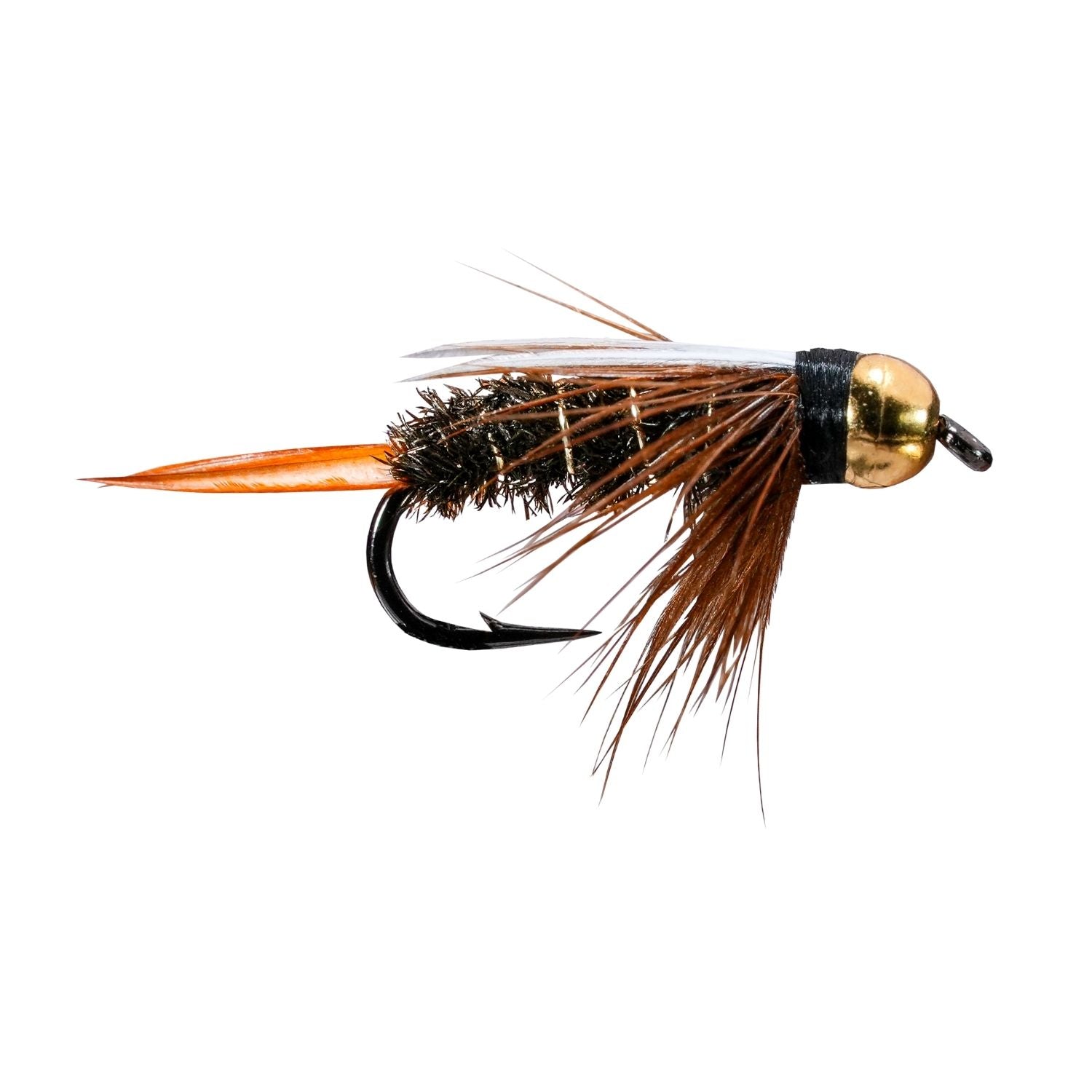
Imitates: General attractor (Stonefly nymphs/ mayfly blend)
Use: Dead-drifted in nymph rigs, dropper under a dry fly, or Euro-style jig variation for better drift and less snags
Tying Video: tying the Prince Nymph
Additional Videos: more YouTube Videos
Search Google: for Jigged Prince Nymph
A twist on the classic Prince Nymph, a jigged version rides hook-up for fewer snags and better bounce in the drift. The Prince Nymph is a classic, all-purpose attractor nymph that has earned a place in nearly every fly box. Its signature peacock herl body, white goose biot wings, and split tail create a buggy, high-contrast profile that draws attention in a wide range of water types and conditions. Though not designed to imitate a specific insect, it evokes enough characteristics of stoneflies, mayflies, and caddis larvae to fool even selective trout.
Its extra weight allows it to sink quickly, making it ideal for deep pockets, faster riffles, and dropper setups. In summer, it’s especially productive during mixed hatches or when trout are opportunistically feeding. The flash from the peacock herl and ribbing adds to its visibility, while the silhouette keeps it believable.
Fish the Prince Nymph year-round — it works equally well in high-mountain creeks, tailwaters, and freestone rivers. It pairs well as the anchor fly in a double nymph rig and is highly effective in dry-dropper presentations when used under larger dries like the Royal Wulff or Chubby Chernobyl. The jigged version is popular in Euro-nymphing setups, reducing snags and improving presentation.
Whether you’re prospecting unfamiliar water or want to tempt trout when nothing else is working, the Prince Nymph is a proven performer that deserves to be in every angler’s summer lineup.
6. Elk Hair Caddis (Size 12–18)
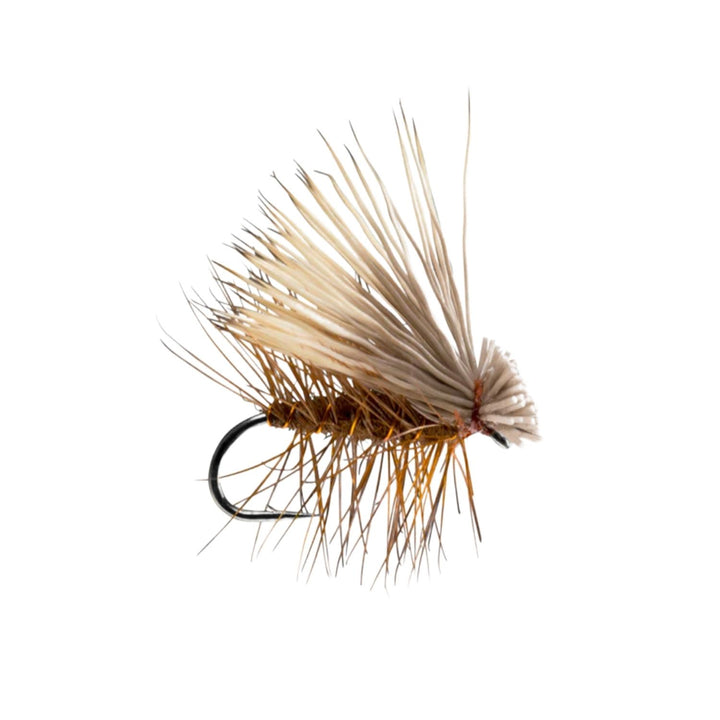
Imitates: Adult caddisflies, sometimes mistaken for small stoneflies or terrestrials
Use: Dry fly for riffles, banks, and pocket water — can be dead drifted or skittered
Tying Video: Tying the Elk Hair Caddis
Additional Videos: More YouTube Videos
Search Google: for Elk Hair Caddis
The Elk Hair Caddis is one of the most iconic and effective dry flies for summer fly fishing. Designed by Al Troth, in the 1950s, it mimics adult caddisflies that bounce, flutter, or skate across the water’s surface. Its bushy hackle and stiff elk hair wing allow it to ride high even in turbulent riffles or choppy water. The pattern is remarkably durable, making it perfect for fishing fast runs and aggressive risers.
Best used during late spring through early fall, the Elk Hair Caddis excels in evening caddis hatches when adults return to lay eggs. It’s deadly when dead-drifted along seams and pocket water, but don’t hesitate to give it some action — twitching or skating the fly can trigger explosive takes when trout are keyed in on movement. It’s also ideal for use as the top fly in a dry-dropper rig, with its strong floatation easily supporting a beadhead nymph below.
This fly’s versatility makes it a must-have in any summer box. Sizes 14–18 are most common, with tan, olive, and black being the most effective colors depending on the local caddis species. For best performance, apply a gel floatant before the first cast and use a desiccant powder to restore buoyancy throughout the day. Whether you’re prospecting new water or targeting rising fish during a hatch, the Elk Hair Caddis remains a top-tier choice.
7. Parachute Adams (Size 12–18)

Imitates: Mayfly adults, general attractor
Use: Solo dry or dry-dropper rig during mayfly hatches or as an all-purpose dry fly
Tying Video: Tying the Parachute Adams
Additional Videos: Additional YouTube Videos
Search Google: for Parachute Adams
The Parachute Adams is a universal dry fly that imitates adult mayflies and covers a wide range of surface-feeding scenarios. Its neutral gray body, brown hackle, and white post give it a realistic silhouette and excellent visibility for anglers. While designed to match a mayfly dun, trout often take it even in the absence of a hatch, making it a fantastic searching pattern or general attractor. The parachute hackle keeps it riding flush in the film, where naturals tend to drift.
Use it wherever you find rising fish — riffles, seams, back eddies, or slick tailouts. It performs especially well in the summer and fall when trout are keying in on mayflies like PMDs, BWOs, or Tricos. Pair it with a Zebra Midge, Pheasant Tail, or other small nymph as a dropper to cover multiple water columns. Sizes 14 through 18 are standard, but having a few size 20s on hand can make the difference during a small hatch. When visibility is tough, the white post helps track your fly through glare or chop.
8. Griffith’s Gnat (Size 18–20)
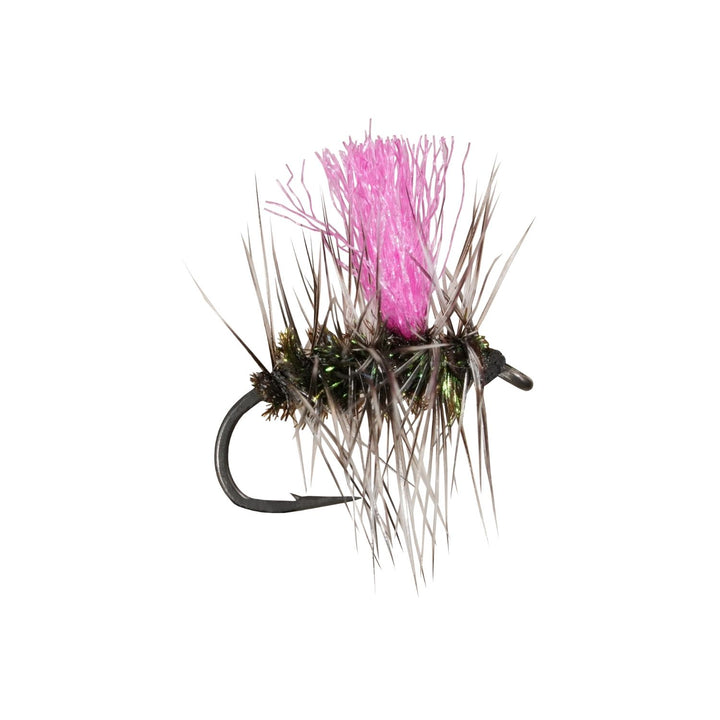
Imitates: Midges, Trico clusters
Use: Effective during summer midge or trico hatches
Tying Videos: Tying videos
Additional Videos: Tying videos
Search Google Images: for Griffiths Gnats
Griffith’s Gnat is one of the most versatile small dry flies for fooling picky trout. It mimics a cluster of midges — or even a single adult — which is exactly what fish target in slow water, especially when little else is hatching. Though best known as a winter pattern, it shines in the summer too, particularly during low water and when trout refuse larger offerings. Its simple build — peacock herl body and sparse hackle — makes it surprisingly durable, and it rides low in the film like the real thing.
Use a long, fine leader (5X–7X) and aim for a perfectly drag-free drift. It performs well solo or as part of a double dry fly rig with a more visible pattern like a small Parachute Adams. This fly is a lifesaver when trout are sipping tiny bugs in glassy pools, spring creeks, or tailouts. Summer evenings and cloudy afternoons often bring subtle midge hatches where this pattern can outfish all others. Apply gel floatant before casting and refresh with powder floatant as needed to keep it riding high.
9. Trico Adult (Size 20–24)
Imitates: Trico mayflies
Use: Early morning and late evening hatches, late summer to fall
Tying Videos: Charlie Craven’s Trico Spinner
Additional Videos: Other YouTube Videos
Search Google Images: for Trico Spinner Images
The Trico Spinner is a delicate, flush-floating dry fly that imitates the final, spent stage of the Tricorythodes mayfly. During calm summer mornings—often in July through September—massive spinner falls cover the surface, and trout selectively sip these tiny, motionless bugs. This pattern matches the key silhouette with its splayed wings and slim body. It’s best fished on a long, light leader (6X–7X) with a dead-drift across slick tailouts, seams, and spring creek runs. When visibility is tough, trail it behind a more visible dry like a Parachute Adams.
While the spinner is the most famous stage, anglers also target Tricos during the nymph stage just before the hatch and the emerger/dun stage as they rise to the surface. A full approach to Trico fishing involves starting with tiny nymphs at first light, then switching to emergers and finally spinners as the hatch progresses. But during a heavy spinner fall, this fly, the spinner, is often the only one that gets results.
10. Zebra Midge (Size 14–18)
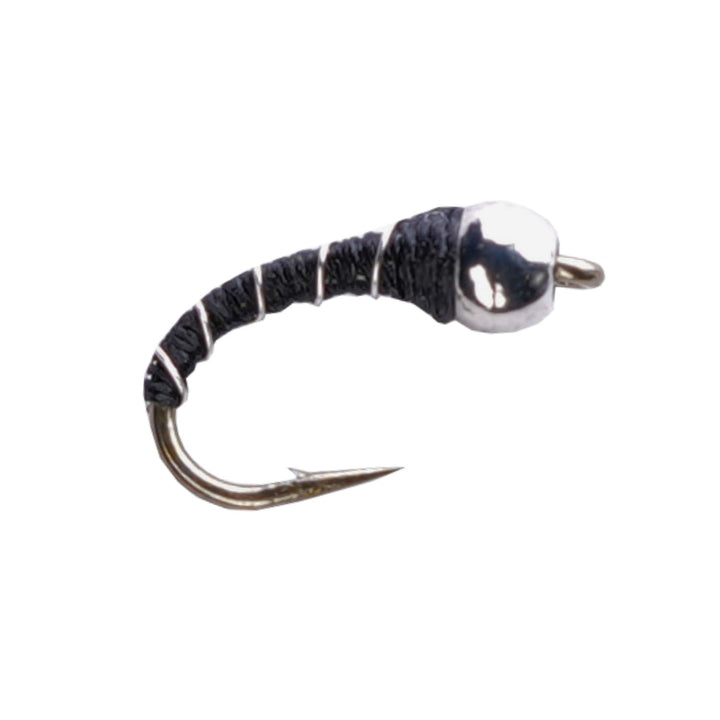
Imitates: Migdge larva
Use: Subsurface nymph, especially in double nymph or dry-dropper rigs
Tying Videos: Tying videos
Additional Videos: Tying videos
The Zebra Midge is a minimalist nymph pattern that’s incredibly effective across a wide range of waters and seasons. It mimics the slender profile of midge larvae or pupae—tiny, protein-rich insects that trout feed on all year long. In summer, it excels in technical fisheries like spring creeks and tailwaters, where midges hatch even during hot weather and trout become selective. The fly’s bead head helps it sink rapidly into the feeding zone, and the wire ribbing adds both durability and subtle flash. Whether you’re targeting pressured fish in low flows or searching deep pools on a bright summer day, the Zebra Midge remains a top choice.
How to Fish It:
- Double Nymph Rig: Use it as a trailing fly behind a larger nymph (e.g., Pheasant Tail or Perdigon) to cover both food sizes and depths.
- Dry-Dropper Setup: Drop it below a small, visible dry fly like a Parachute Adams or Elk Hair Caddis for spooky trout in clear water.
- Winter Midge Hatch: Fish it near the bottom or just off the bottom during winter or early spring midge hatches when trout feed selectively on small prey.
- Tightline Nymphing: Euro-nymphing with a Zebra Midge as the anchor fly allows you to feel subtle takes in slower runs.
Extra Tips:
- Choose black, red, or olive color variations depending on the local midge population and water clarity.
- Use fine tippet (5x–7x) to maintain a natural drift and avoid spooking fish in gin-clear water.
- Use a smaller, low-profile indicator or tightline technique to detect subtle takes.
11. Elk Hair Stimulator (Size 8–10)
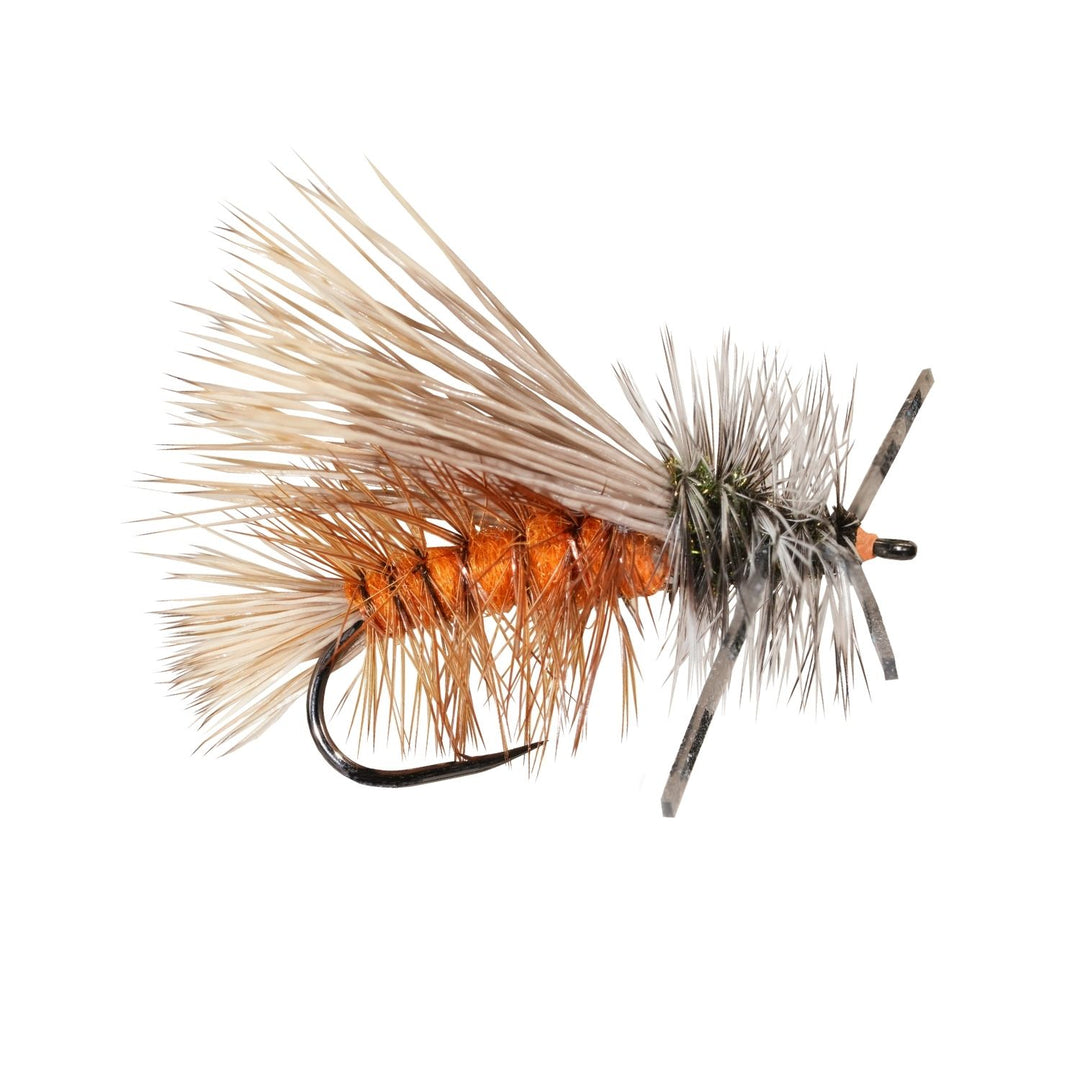
Imitates: An all-purpose high-floating attractor that suggests stoneflies, caddis adults, hoppers, or just a big buggy meal.
Use: Fished alone or as a dry-dropper lead fly in riffles, pockets, and summer bankside runs
Tying Videos: Randal Kaufman ties his Stimulator
Additional Videos: Other Stimulator Tying Videos
Search Google: for Stimulator Fly Pattern
The Stimulator is a legendary attractor dry fly known for its buoyancy, visibility, and rugged design. Its heavily hackled body and bushy elk hair wing allow it to float high through turbulent water, making it ideal for mountain creeks, freestone rivers, and summer riffles. The pattern’s buggy profile imitates a range of large insects including stoneflies, adult caddis, and grasshoppers. The orange or yellow versions are especially effective during golden stonefly or hopper activity.
How to Fish It:
- Solo on a Tapered Leader: Cast upstream or across to riffles, pocket water, and foam seams. Let it drift naturally with occasional twitches to mimic a struggling insect.
- Dry-Dropper Rig: Tie a Stimulator as the top dry fly with a tungsten beadhead nymph (e.g., Perdigon, Pheasant Tail, or Caddis Larva) suspended 18–24 inches below.
- Bank Work: Target grassy edges, overhanging trees, and undercut banks where terrestrial insects are likely to fall in.
- Stillwater Drift: In alpine lakes, fish it with a slow drag or twitch near drop-offs or rocky points where hoppers land in the water.
Extra Tips:
- Apply floatant generously to the hackle and wing, and re-dress after every few fish or dunkings.
- Consider using a slightly oversized Stimulator (size 8–10) as a strike indicator in skinny water or small streams.
- Try twitching or skittering the fly near the end of the drift to trigger aggressive takes, especially from opportunistic trout in faster water.
12. Half Baked Caddis (Size 14–16)

Imitates: Caddis pupae and emerging adults trapped just below the surface — exactly the stage when trout feed most aggressively.
Use: Dead drifted or swung during caddis hatches
Tying Videos: No videos are available
The Half Baked Caddis is a highly effective pattern that imitates a caddis pupa transitioning into an adult. Its two-tone dubbing, soft hackle, and emerging bubble effect provide a realistic profile trout find irresistible. This fly performs best during active caddis hatches in the summer, especially when dead drifted near the bottom or swung just below the surface film.
To fish this fly effectively:
- Dead Drift: Cast upstream or at an angle with an indicator or tight-line method. Let the fly drift drag-free near the bottom where pupae emerge.
- Swing the Fly: Cast quartering downstream, allowing the fly to rise at the end of the drift, mimicking the natural emergence movement.
- Film Presentation: Grease the leader except for the final few inches to suspend the fly just below the surface for targeting trout feeding in the film.
- Dry-Dropper Rig: Use beneath a buoyant dry fly to imitate the natural emergence process while covering two zones of the water column.
13. CDA Caddis (Size 14–16)
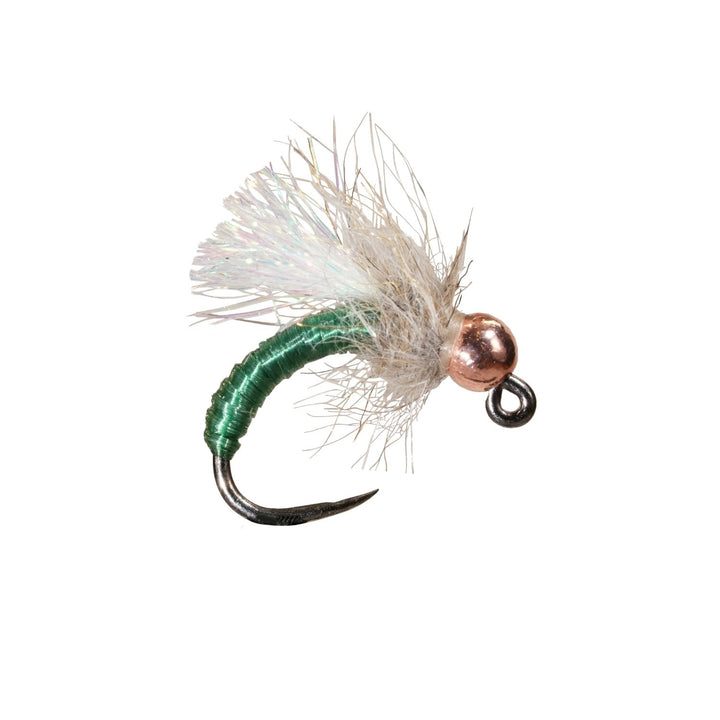
Imitates:Caddis larvae living on the river bottom or pupae rising to hatch on the surface
Use: Surface skittering, dead drifting in summer evenings
Tying Videos: No Tying videos are available for the CDA Caddis
The CDA Caddis is a nymph designed to mimic both the larval and pupal stages of the caddisfly. Its slim, buggy profile and shimmery body imitate either a caddis larva crawling along the bottom or a gas-bubble-ridden pupa rising to hatch at the surface. With its natural drift and quick sink rate, it is particularly effective during peak caddis seasons and proves deadly when trout are actively feeding below the surface.
One of the CDA Caddis’s standout features is its ability to function as both a point fly in a two-fly rig and as a dropper under a buoyant dry fly like a Foam Caddis or Chubby Chernobyl. Anglers value its versatility: it excels when dead-drifted through riffles and runs or when suspended mid-column to imitate ascending pupae. The fly’s shimmery body reflects light in a way that mimics the gas bubbles real pupae use to rise—an irresistible trigger for trout.
Online sources and pro anglers note that early in a caddis hatch, trout often hold near the bottom, feeding on drifting larva and emerging pupae. As hatches progress, fish rise through the water column to intercept ascending insects. This behavior makes the CDA Caddis especially powerful, allowing anglers to adapt their presentations throughout the hatch. Swinging the fly near the end of a drift can imitate a pupa breaking free and swimming upward—often resulting in explosive strikes.
Euro-nymph anglers often tie variations of the CDA Caddis on jig hooks with slotted tungsten beads and CDC collars, giving it lifelike movement and snag-free drifts through seams and pockets. The slim profile ensures a quick sink rate even in faster water, while soft hackle adds movement that mimics emerging legs and wings.
Where and When to Use: The CDA Caddis is ideal for pocket water, deep runs, and fast riffles from spring through early fall—essentially any time caddis are active. It is especially effective just before or during hatches, when fish begin feeding more aggressively on subsurface stages.
Pro Tip: Anglers targeting cutthroat trout report especially strong success with this pattern. If you fish waters where cutthroat live, be sure to keep a few CDA Caddis flies in your box.
Best Presentations:
- Dead-drifted near the bottom in a double nymph rig
- Suspended beneath a high-floating dry fly in a dry-dropper setup
- Lifted at the end of the drift to simulate emerging pupae
- Swung across seams to trigger strikes on the rise
Whether you’re matching a drifting larva or an emerging pupa, the CDA Caddis delivers a highly effective presentation. Its combination of realism, movement, and shimmer make it a smart, multipurpose pattern that earns its place in any serious trout angler’s lineup.



